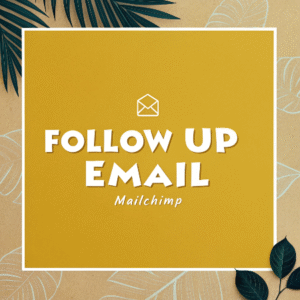Follow-up email are very useful in digital marketing. They help people remember your brand. Mailchimp makes follow-up emails simple to send. It is one of the best email tools. Many businesses use it to keep in touch with customers. When someone signs up or buys something, you can send a follow-up. This message can thank them or remind them. It builds strong connections. It also helps to get better results.
Follow-up email do not need to be long. They just need to be clear and helpful. Using Mailchimp, you can set these emails to send automatically. You don’t need to do it by hand each time. This saves time and increases response rates.
In this article, you will learn how to create follow-up emails using Mailchimp. We will cover steps, tips, and tricks. Let’s start by understanding what follow-up emails are and why they matter.
What Are Follow-Up Email?
Follow-up emails are messages sent after someone takes action. For example, someone may sign up for your newsletter. You can then send a follow-up email. This email can welcome them or provide more details. These emails help keep the conversation going. That way, people do not forget your business.
Mailchimp helps you send these telemarketing data emails easily. It allows you to make a plan. You can send emails after someone opens your message or clicks a link. This is called an email automation. You only set it once. Then it keeps working for you.
A good follow-up email is short and friendly. You can also add useful links or offers. This keeps the reader interested in your message. If done well, follow-up emails bring great results.
Why Follow-Up Emails Are Important
Follow-up emails show that you care. When you check in, people feel valued. This can lead to more trust. Trust leads to more business. Also, not everyone replies the first time. A follow-up can remind them to take action.
Sometimes, people read your first email but forget to respond. Sending a second message helps them remember. Also, follow-up emails can offer help. If someone had trouble, you can solve it. That helps improve your service.
Mailchimp makes follow-ups easy to manage. You can track who opened your email. Then you can send a second email to those people. This helps improve your success.
Types of Follow-Up Emails You Can Send
There are many kinds of follow-up emails. The type depends on your goal. One type is the welcome email. It says hello and thanks someone for joining your list. Another is the thank-you email. This shows your appreciation after a sale.
You can also send a reminder. If someone left items in a cart, you remind them. There are also event follow-ups. After a webinar or class, you send a note. This can include a summary or next steps. These emails help people remember you.
Also, Mailchimp lets you build a whole series of emails. This is called an email sequence. Each message follows the last one. This can guide people toward a goal, like signing up or buying.
How to Set Up Follow-Up Emails in Mailchimp
Start by logging in to your Mailchimp account. Choose “Automations” from the main menu. Then click on “Customer Journey” or “Classic Automations.” Next, pick your trigger. This is the action that starts the follow-up. For example, a new sign-up.
Now, write your email. Keep it simple and clear. Use a subject line that gets attention. Inside the email, add value. Give tips, offer a discount, or just say thank you.
After writing, test your email. Mailchimp lets you preview it. Check spelling and layout. Once it’s ready, turn on the automation. Your follow-up email will now send on its own.
Tips for Writing Great Follow-Up Emails
Use a friendly tone. Write like you’re talking to a friend. Keep your message short. Add a call-to-action (CTA). This is what you want the reader to do. For example, “Click here to learn more.”
Use clear subject lines. People often choose to open or delete based on the subject. Make yours strong. You can ask a question or say something exciting.
Also, send your email at the right time. Don’t wait too long. But also don’t send too fast. Give people a little space.
Mistakes to Avoid in Follow-Up Emails
Don’t send too many emails. People get tired and may unsubscribe. Also, don’t be too pushy. You want to help, not bother.
Avoid spelling errors. They make your email look unprofessional. Always check before you send. Also, make sure your links work. Test everything.

Don’t forget to include a way to contact you. People may have questions. Make it easy for them to reply or reach out.
When to Send a Follow-Up Email
Timing is important. Send your first follow-up within 24 hours. After that, you can send another in a few days. If someone clicks a link, you can send a second email quickly.
If someone buys something, follow up with a thank-you message. Later, you can suggest other items. This helps increase sales.
If you do not hear back, send one last message. Keep it kind and short. Some people may need a gentle nudge.
How Mailchimp Helps With Automation
Mailchimp has great tools for follow-ups. You can build workflows. A workflow is a set of emails that send in order. You choose the time and the trigger.
Mailchimp also shows you reports. You can see who opened your emails. You can check which links they clicked. This helps you learn what works.
Use that data to improve your emails. Try new subject lines. Change your message if needed. Over time, your emails will get better.
Using Tags and Segments in Mailchimp
Tags and segments help target the right people. A tag is like a label. For example, “New Customer” or “Event Attendee.”
A segment is a group of people. You can make a segment of people who opened your last email. Then, send a follow-up only to them.
This makes your email more personal. People like to get messages that feel made for them.
Examples of Follow-Up Email Templates
Mailchimp gives you free templates. You can pick one and change it. There are templates for welcome emails. Others are for reminders or thank-you notes.
Start with a basic layout. Add your logo. Write a nice message. Use buttons for links. That makes your email easy to read.
Use colors that match your brand. Add a photo if it helps. Keep the design clean and simple. This makes the message clear.
How to Measure Your Follow-Up Email Success
After sending, check your reports. Look at your open rate. That shows how many people read it.
Also, check your click rate. This tells you if they clicked your links. If the rates are low, try changing your subject line.
You can also try A/B testing. Send two versions of the same email. See which one does better. Then use that to guide your next email.
Why Mailchimp Is Good for Follow-Up Emails
Mailchimp is easy to use. Even mastering group email in gmail: your easy guide beginners can learn quickly. It gives you ready templates. You also get automation tools. These save you time and effort.
The reports help you improve. You can see what works and what does not. You can then update your emails.
Also, Mailchimp lets you connect with your website. This makes your work even smoother. All these features help you build strong follow-up emails.
Final Thoughts on Follow-Up Emails in Mailchimp
Follow-up emails are powerful. They whatsapp filter help you stay in touch. They also help grow your business. Mailchimp gives you tools to make it easy.
Start with one follow-up email. Then, build a full series. Use data to make changes. Always try to give value to your readers.
Keep learning. Try new ideas. Read your reports. Over time, you will see more results. Follow-up emails are not hard to make. With Mailchimp, they can work for you all the time.
